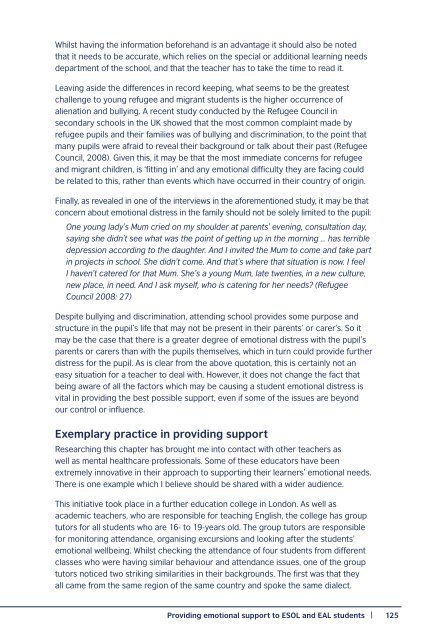Innovations in English language teaching for migrants and refugees
Innovations in English language teaching for migrants and refugees
Innovations in English language teaching for migrants and refugees
Create successful ePaper yourself
Turn your PDF publications into a flip-book with our unique Google optimized e-Paper software.
Whilst hav<strong>in</strong>g the <strong>in</strong><strong>for</strong>mation be<strong>for</strong>eh<strong>and</strong> is an advantage it should also be noted<br />
that it needs to be accurate, which relies on the special or additional learn<strong>in</strong>g needs<br />
department of the school, <strong>and</strong> that the teacher has to take the time to read it.<br />
Leav<strong>in</strong>g aside the differences <strong>in</strong> record keep<strong>in</strong>g, what seems to be the greatest<br />
challenge to young refugee <strong>and</strong> migrant students is the higher occurrence of<br />
alienation <strong>and</strong> bully<strong>in</strong>g. A recent study conducted by the Refugee Council <strong>in</strong><br />
secondary schools <strong>in</strong> the UK showed that the most common compla<strong>in</strong>t made by<br />
refugee pupils <strong>and</strong> their families was of bully<strong>in</strong>g <strong>and</strong> discrim<strong>in</strong>ation, to the po<strong>in</strong>t that<br />
many pupils were afraid to reveal their background or talk about their past (Refugee<br />
Council, 2008). Given this, it may be that the most immediate concerns <strong>for</strong> refugee<br />
<strong>and</strong> migrant children, is ‘fitt<strong>in</strong>g <strong>in</strong>’ <strong>and</strong> any emotional difficulty they are fac<strong>in</strong>g could<br />
be related to this, rather than events which have occurred <strong>in</strong> their country of orig<strong>in</strong>.<br />
F<strong>in</strong>ally, as revealed <strong>in</strong> one of the <strong>in</strong>terviews <strong>in</strong> the a<strong>for</strong>ementioned study, it may be that<br />
concern about emotional distress <strong>in</strong> the family should not be solely limited to the pupil:<br />
One young lady’s Mum cried on my shoulder at parents’ even<strong>in</strong>g, consultation day,<br />
say<strong>in</strong>g she didn’t see what was the po<strong>in</strong>t of gett<strong>in</strong>g up <strong>in</strong> the morn<strong>in</strong>g … has terrible<br />
depression accord<strong>in</strong>g to the daughter. And I <strong>in</strong>vited the Mum to come <strong>and</strong> take part<br />
<strong>in</strong> projects <strong>in</strong> school. She didn’t come. And that’s where that situation is now. I feel<br />
I haven’t catered <strong>for</strong> that Mum. She’s a young Mum, late twenties, <strong>in</strong> a new culture,<br />
new place, <strong>in</strong> need. And I ask myself, who is cater<strong>in</strong>g <strong>for</strong> her needs? (Refugee<br />
Council 2008: 27)<br />
Despite bully<strong>in</strong>g <strong>and</strong> discrim<strong>in</strong>ation, attend<strong>in</strong>g school provides some purpose <strong>and</strong><br />
structure <strong>in</strong> the pupil’s life that may not be present <strong>in</strong> their parents’ or carer’s. So it<br />
may be the case that there is a greater degree of emotional distress with the pupil’s<br />
parents or carers than with the pupils themselves, which <strong>in</strong> turn could provide further<br />
distress <strong>for</strong> the pupil. As is clear from the above quotation, this is certa<strong>in</strong>ly not an<br />
easy situation <strong>for</strong> a teacher to deal with. However, it does not change the fact that<br />
be<strong>in</strong>g aware of all the factors which may be caus<strong>in</strong>g a student emotional distress is<br />
vital <strong>in</strong> provid<strong>in</strong>g the best possible support, even if some of the issues are beyond<br />
our control or <strong>in</strong>fluence.<br />
Exemplary practice <strong>in</strong> provid<strong>in</strong>g support<br />
Research<strong>in</strong>g this chapter has brought me <strong>in</strong>to contact with other teachers as<br />
well as mental healthcare professionals. Some of these educators have been<br />
extremely <strong>in</strong>novative <strong>in</strong> their approach to support<strong>in</strong>g their learners’ emotional needs.<br />
There is one example which I believe should be shared with a wider audience.<br />
This <strong>in</strong>itiative took place <strong>in</strong> a further education college <strong>in</strong> London. As well as<br />
academic teachers, who are responsible <strong>for</strong> teach<strong>in</strong>g <strong>English</strong>, the college has group<br />
tutors <strong>for</strong> all students who are 16- to 19-years old. The group tutors are responsible<br />
<strong>for</strong> monitor<strong>in</strong>g attendance, organis<strong>in</strong>g excursions <strong>and</strong> look<strong>in</strong>g after the students’<br />
emotional wellbe<strong>in</strong>g. Whilst check<strong>in</strong>g the attendance of four students from different<br />
classes who were hav<strong>in</strong>g similar behaviour <strong>and</strong> attendance issues, one of the group<br />
tutors noticed two strik<strong>in</strong>g similarities <strong>in</strong> their backgrounds. The first was that they<br />
all came from the same region of the same country <strong>and</strong> spoke the same dialect.<br />
Provid<strong>in</strong>g emotional support to ESOL <strong>and</strong> EAL students | 125


